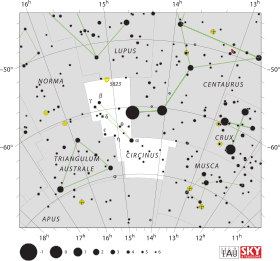Alpha Circini
 | |
| Observation data Epoch J2000.0 Equinox J2000.0 (ICRS) | |
|---|---|
| Constellation | Circinus |
| Right ascension | 14h 42m 30.41958s[1] |
| Declination | −64° 58′ 30.4934″[1] |
| Apparent magnitude (V) | 3.18 - 3.21[2] |
| Characteristics | |
| Spectral type | A7 Vp SrCrEu[3] |
| U−B color index | +0.12[4] |
| B−V color index | +0.24[4] |
| Variable type | roAp[2] |
| Astrometry | |
| Radial velocity (Rv) | +7.2[5] km/s |
| Proper motion (μ) | RA: −192.53[1] mas/yr Dec.: −233.51[1] mas/yr |
| Parallax (π) | 60.35 ± 0.14[1] mas |
| Distance | 54.0 ± 0.1 ly (16.57 ± 0.04 pc) |
| Absolute magnitude (MV) | +2.18[6] |
| Details | |
| Mass | 1.5–1.7[7] M☉ |
| Radius | 1.967 ± 0.066[8] R☉ |
| Luminosity | 10.51 ± 0.60[7] L☉ |
| Surface gravity (log g) | 4.1[7] cgs |
| Temperature | 7,500[7] K |
| Metallicity [Fe/H] | 0.13[9] dex |
| Rotation | 4.4790 ± 0.0001 days[10] |
| Rotational velocity (v sin i) | 13.0 ± 1.5[10] km/s |
| Age | ~12 million[11] years |
| Other designations | |
| Database references | |
| SIMBAD | data |
Alpha Circini (α Cir, α Circini) is a variable star in the faint, southern, circumpolar constellation of Circinus. At an apparent visual magnitude of 3.19,[4] it is the brightest star in the constellation and can be readily seen with the naked eye from the southern hemisphere. Parallax measurements of this star yield an estimated distance of 54.0 light-years (16.6 parsecs) from the Earth.[1]
This star belongs to a class of variables known as rapidly oscillating Ap stars. It oscillates with multiple, non-radial pulsation cycles and a dominant cycle of 6.8 minutes.[10] The spectrum shows peculiar features caused by chemical stratification of the outer atmosphere. It displays a moderate deficiency of carbon, nitrogen and oxygen, while there is an overabundance of chromium (Cr).[7] The stellar classification of A7 Vp SrCrEu[3] indicates that this is a main sequence star with enhanced levels of strontium (Sr), chromium, and europium (Eu) in its atmosphere (compared to a typical star like the Sun).[14]
The mass of Alpha Circini is about 150% to 170% the mass of the Sun[7] and it has double the Sun's radius,[8] while the luminosity is more than 10 times that of the Sun. The effective temperature of the outer envelope is about 7,500 K, giving it the white hue typical of A-type stars.[7][15] It is rotating with a period of 4.5 days and the pole is inclined by about 37 ± 4° to the line of sight from the Earth.[10]
Based upon its location and motion through space, Alpha Circini is a candidate member of a stellar kinematic group known as the Beta Pictoris moving group. This group shares a common origin and has an estimated age of about 12 million years. At the birth of this group, Alpha Circini was estimated to be located at a distance of about 91 ly (28 pc) from the center of the assemblage.[11]
References
- 1 2 3 4 5 6 van Leeuwen, F. (November 2007), "Validation of the new Hipparcos reduction", Astronomy and Astrophysics, 474 (2): 653–664, arXiv:0708.1752, Bibcode:2007A&A...474..653V, doi:10.1051/0004-6361:20078357
- 1 2 Samus, N. N.; Durlevich, O. V.; et al. (2009). "VizieR Online Data Catalog: General Catalogue of Variable Stars (Samus+ 2007-2013)". VizieR On-line Data Catalog: B/gcvs. Originally published in: 2009yCat....102025S. 1. Bibcode:2009yCat....102025S.
- 1 2 Gray, R. O.; et al. (July 2006), "Contributions to the Nearby Stars (NStars) Project: Spectroscopy of Stars Earlier than M0 within 40 parsecs: The Northern Sample I", The Astronomical Journal, 132 (1): 161–170, arXiv:astro-ph/0603770, Bibcode:2006AJ....132..161G, doi:10.1086/504637
- 1 2 3 Johnson, H. L.; et al. (1966), "UBVRIJKL photometry of the bright stars", Communications of the Lunar and Planetary Laboratory, 4 (99): 99, Bibcode:1966CoLPL...4...99J
- ↑ Evans, D. S. (June 20–24, 1966), Batten, Alan Henry; Heard, John Frederick, eds., "The Revision of the General Catalogue of Radial Velocities", Determination of Radial Velocities and their Applications, University of Toronto: International Astronomical Union, 30: 57, Bibcode:1967IAUS...30...57E
- ↑ Ammler-von Eiff, M.; Reiners, A. (June 2012), "New measurements of rotation and differential rotation in A-F stars: are there two populations of differentially rotating stars?", Astronomy & Astrophysics, 542: A116, arXiv:1204.2459, Bibcode:2012A&A...542A.116A, doi:10.1051/0004-6361/201118724.
- 1 2 3 4 5 6 7 Kochukhov, O.; Shulyak, D.; Ryabchikova, T. (June 2009), "A self-consistent empirical model atmosphere, abundance and stratification analysis of the benchmark roAp star α Circini", Astronomy and Astrophysics, 499 (3): 851–863, arXiv:0903.3512, Bibcode:2009A&A...499..851K, doi:10.1051/0004-6361/200911653
- 1 2 Bruntt, H.; et al. (June 2008), "The fundamental parameters of the roAp star α Circini", Monthly Notices of the Royal Astronomical Society, 386 (4): 2039–2046, arXiv:0803.1518, Bibcode:2008MNRAS.386.2039B, doi:10.1111/j.1365-2966.2008.13167.x
- ↑ North, P.; Berthet, S.; Lanz, T. (January 1994), "The nature of the F STR lambda 4077 stars. 3: Spectroscopy of the barium dwarfs and other CP stars", Astronomy and Astrophysics, 281 (3): 775–796, Bibcode:1994A&A...281..775N
- 1 2 3 4 Bruntt, H.; et al. (June 2009), "Asteroseismic analysis of the roAp star α Circini: 84d of high-precision photometry from the WIRE satellite", Monthly Notices of the Royal Astronomical Society, 396 (2): 1189–1201, arXiv:0903.3967, Bibcode:2009MNRAS.396.1189B, doi:10.1111/j.1365-2966.2009.14804.x
- 1 2 Nakajima, Tadashi; Morino, Jun-Ichi; Fukagawa, Misato (September 2010), "Potential Members of Stellar Kinematical Groups within 20 pc of the Sun", The Astronomical Journal, 140 (3): 713–722, Bibcode:2010AJ....140..713N, doi:10.1088/0004-6256/140/3/713
- ↑ Gould, Benjamin Apthorp (1879), "Uranometria Argentina", Resultados del Observatorio Nacional Argentino en Cordoba, Buenos Aires, 1: 385, Bibcode:1879RNAO....1.....G. See VizieR catalogue V/135A.
- ↑ "* alf Cir". SIMBAD. Centre de données astronomiques de Strasbourg. Retrieved 2012-01-04.
- ↑ Kaler, James B., "ALPHA CIR (Alpha Circini)", Stars, University of Illinois, retrieved 2012-01-04
- ↑ "The Colour of Stars", Australia Telescope, Outreach and Education, Commonwealth Scientific and Industrial Research Organisation, December 21, 2004, archived from the original on March 10, 2012, retrieved 2012-01-16